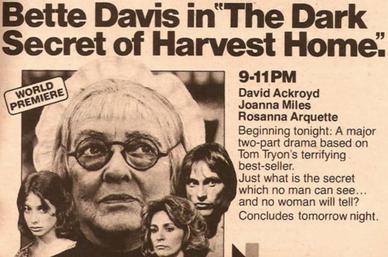It’s 4 October, and we are proceeding at a steady pace towards Halloween. Before you know it, we’ll all be on the phone to our local TV stations, screaming at them at the top of our lungs to stop it, Stop It, STOP IT!
But that’s for later. For now let us continue down the path that L.A.’s Cinematic Void prepared for us. According to The 31 Days of Voidoween, today is all about “Folk Horror,” that somewhat newish genre of film that seems to be everywhere nowadays. It’s kind of like film noir. It’s a critics’ term that was defined well after the films that serve as its prime examples were released. If you’re interested, I’ve got more to say about the genre in an earlier entry on this blog -- check out my discussion of Nigel Kneale’s “Murrain.” Today, I want to talk about a folk horror novel that I think should be read much more than it seems to be. Let’s talk Harvest Home by Thomas Tryon.
"It isn't a great book, not a great horror novel, not even a great suspense novel ... Never mind the best seller list. Mind this, instead: Sentence by sentence, paragraph by paragraph, it is a true book; it is an honest book in the sense that it says exactly what Tryon wanted to say. And if what he wanted to say wasn't exactly Miltonian, it does have this going for it: in forty years, when most of us are underground, there will still be a routine rebinding once a year for the library copies of Harvest Home.”
I think ol’ Stevie maybe got it backwards, because I think Harvest Home is a pretty terrific (in all senses of the word) book that very few people read anymore, let alone are even aware of. (I’d be interested to know the condition of the book at my local library and whether or not it is lovingly rebound year after year.) When I went to see Ari Aster’s Midsommar a few years ago, I was somewhat surprised by the amount of people who thought it was so original and daring. I said to my wife at the time, “It’s like no one’s ever heard of The Wicker Man or Harvest Home.” She turned to me and said, “What’s Harvest Home?”
See what I mean?
Harvest Home is an example of what I like to call the “Return to Nature” genre that became very popular in the 1970s. RtN texts usually concern a person or group of people who decide that they can’t live in the city anymore. It’s just too dangerous and dirty and anti-human. So, they pull stakes and split the scene and make for the countryside. You know, where people are more “real” (whatever that means) and where they can live off the land. So far, we can consider Green Acres to be part of the Return to Nature genre.
Such is the case in Harvest Home. Ned Constantine moves his wife Bethany and their daughter Kate from New York City to the Connecticut village of Cornwall Coombe. The Coombe seems to be utterly isolated (uh-oh), and the villagers like it that way. They are also very proud that they keep to the “old ways" (UH-oh). They also partake in many festivals throughout the year, culminating with the most important one, “Harvest Home,” which only takes place once every seven years.
UH-OH!
If you don’t feel like sitting down with Tryon’s novel, then track down the made-for-TV movie that was made in the 1970s starring Bette Davis as Widow Fortune, the town’s matriarch.
Fun fact: before he turned his talents to writing, Thomas Tryon was an actor. He appeared on Broadway, TV, and movies in the 1950s and 1960s. Monster kids may recognize his face, if not his name, from the classic I Married a Monster from Outer Space!







No comments:
Post a Comment
What do you think? Let me know!